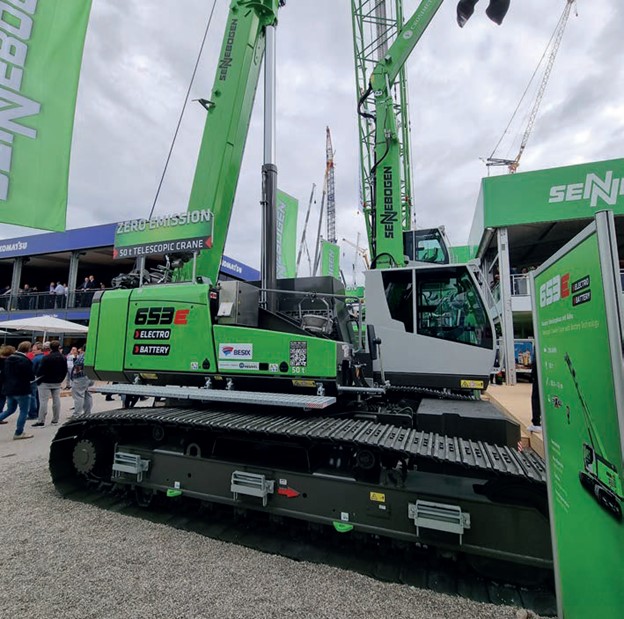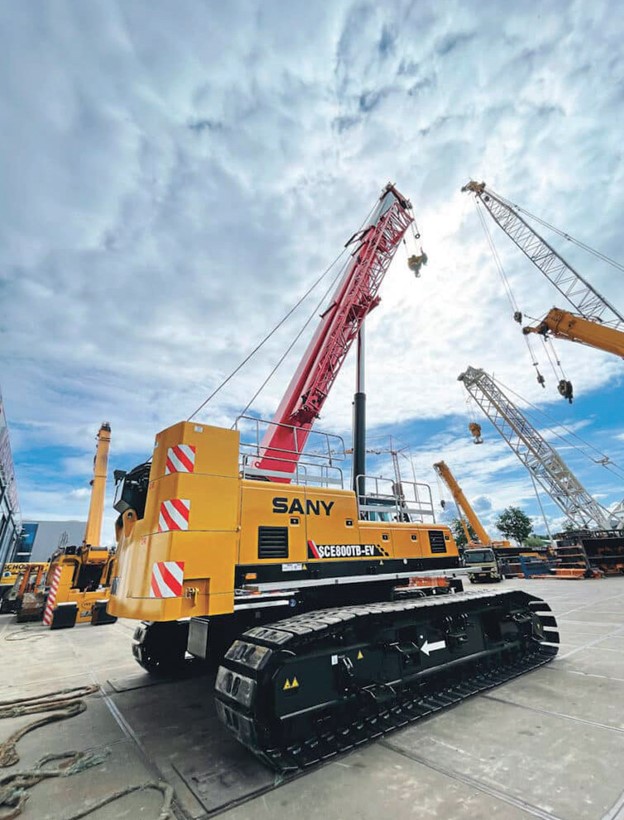Evolution of Electric Telecrawlers
27 October 2023In the last 12 months Sany and Sennebogen have both launched electric telecrawler models. Will North takes a closer look and considers their role in the journey to a carbon-free industry.
In just a few generations, the modern mobile crane industry has evolved into a flourishing and diverse ecosystem. The leaders of some of today's biggest crane companies are the grandchildren and great-grandchildren of innovators who mounted simple A-frames on the back of army surplus jeeps, or found a way to fold and unfold a tower crane on the back of a lorry.
Today, there is a species of mobile crane for every niche. In this millennium, one new species has done particularly well: the telecrawler. These cranes are a fertile hybrid of lattice-boom crawlers and telescopic rough terrains. In many environments, they now dominate. Without tyres or outriggers, they outcompete rough terrains on tough job sites; with a boom that doesn't require extensive rigging, they beat lattice crawlers when time, or long distance transport, are key.
And within this new species of a crane, another is differentiating itself: the electric telecrawler.
In the last year two new models of these cranes have entered the market. They have, in many ways, very different lineages, and will each show their fitness in distinct environments. Together they mark a significant milestone in the evolution of a carbon-free crane industry, and of the world economy as it transitions to Net Zero.
BATTERY SWAP
The larger of these two cranes is the Sany SCE800TB-EV. Sany aspires –like its big domestic rivals, XCMG and Zoomlion, and Japan’s Tadano – to build a business in the Liebherr vein, with multiple crane types offered globally, alongside a wide range of other construction equipment.
Its telecrawlers are in many ways a hybrid of two crane types it already offers: a crawler base similar to those used on a lattice boom machine, and a telescopic boom similar to that of a rough terrain. This has been the standard approach to developing these machines, and Sany has adopted a similar strategy as it transitions to electric power, swapping the diesel engine for a battery.
As the name suggests, this is a like-for-like variant on a preexisting crane, the diesel-powered SCE800TB. The machine offers a nominal capacity of 80t, with a 47m main boom and 17.5m lattice jib. The crane is designed to be transported in three loads: the base machine, at 39.5t; car body and other components at 28t; with counterweight tray and six pieces of ballast coming in at 26t.
The electric variant is powered by an LFP (lithium iron phosphate) battery pack, similar to those used in many big name battery electric cars, from Chinese supplier CATL.
The two companies announced a strategic partnership in 2020, with CATL. The deal was a big deal for both companies: Sany would secure a partner for the electrification of its concrete machinery, mining machinery, cranes, port machinery, excavator and heavy truck lines; CATL would move from passenger vehicles, to heavy equipment. The partnership would also focus on the data side of electrification, with the companies working together to develop battery behaviour tracking and fault self-diagnosis. Electric power is made useful by a motor from Danfoss.
The crane can be fast charged at 200v with a single gun charger, or 400v with a dual gun charger; where these options aren’t available, it can slow charge on a 63A connection. It can work while slow charging, in a similar way to Liebherr’s lattice boom electric cranes.
Sany is offering the crane in Europe through experienced crane dealer UCM Holland. In the UK, it is working with Foster Cranes, and in Norway, with Seatraders. In Australia, Tutt Bryant has bought one.
ELECTRIC, WITH A BATTERY
Sennebogen has always been something of an outlier in the mobile crane industry. Rather than offering cranes as one of many construction equipment types, it offers lifting equipment suitable for uses as diverse as ports and construction sites, scrap yards and waste-to-electricity generation facilities. For many of these sectors, where equipment is brought for long-term, single-site, use, it already supplies electric material handlers.
The 653E is a 50t telecrawler, with a 30.4m telescopic boom, and 13m jib. In the US, where Sennebogen does not sell cranes directly, it is the basis for Manitowoc’s GHC 55. Partly as a result of the diverse uses Sennebogen’s customers put its lifting equipment to, the company routinely offers cranes on a choice of carriers. The 653E is available on wheels with outriggers, with an eye to industrial operations, as the 653 MI, with a pick-and-carry capacity of 21.8t.
Sennebogen worked with its Netherlands dealer, Van den Heuvel, to develop the 653E Electro Battery. Van den Heuvel developed a replacement power system for the crane, with a lithium ion battery pack and electric motor, along with converters, charging system, battery temperature control and monitoring. The dealer also converted the crane’s hydraulic cooling and cab climate control to work with the new power system.
The crane is designed for use with a 32A power system, commonly available on construction sites. From full charge the crane can work up to 14 hours without plugging in. It can also lift while plugged in and stationary, with any excess power being used to top up the batteries.
NEW ENVIRONMENTS
At 50t and 80t capacity, these first two examples of their species squarely target the general construction sector. This is a rapidly changing environment, particularly in the largest European cities, where mayors are increasingly imposing limits on carbon emissions. At the same time, project owners on major sites are pursuing their own Net Zero strategies, and are starting to insist on low emissions working. This may set the conditions for cranes like this to flourish at the expense of diesel machines.
If these cranes prove their worth – and the increased up-front costs of batteries are shown to pay off with reduced fuel and service costs, as the manufacturers predict – then larger machines may follow.
There has been a surge in demand for 100–130t telecrawlers on wind farms, where they are used to assemble larger lattice boom crawlers, and in pick and carry mode to move some turbine components.
It will be a significant PR victory for any developer to be able to claim that their wind farm has been built without carbon emissions. While decarbonising the largest crawlers, and the concrete used for hard stands, is perhaps a long way off, battery electric telecrawlers – along with electric SPMTs, and the increasing use of electric tower cranes on some sites – bring that milestone closer.
Sennebogen’s 653 MI suggests other applications where battery electric technology could offer a winning advantage: in industrial rigging, or for long term use in heavy manufacturing.
Here, it would see itself in competition with a wide range of electric pick and carry cranes, crawler knucklebooms and spidercranes, as well as Liebherr’s LTC 1050-3.1E, which offers electric lifting on a diesel all terrain carrier, or Tadano’s AC 3.045-1 City, when working with the company’s optional E-Pack. The road mobile diesel carrier city cranes may offer more advantages for short term jobs, but it’s easy to imagine sites where other considerations might make a wheeled or tracked electric 653 a better choice.
With fewer mechanical parts, and less management of fuel and engine oil required, cranes like this may be easier to service. Future generations of the species may replace hydraulic pistons with electric components. But for now, these are new machines, and it’s reasonable to expect some teething problems. Once manufacturers compete directly with machines in the same capacity class, customers are going to make their decisions based on the OEM’s service network. With a European headquarters, and a well-established US partner in Manitowoc, Sennebogen may well have an advantage here.


